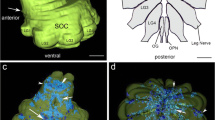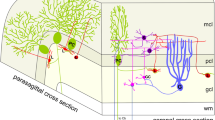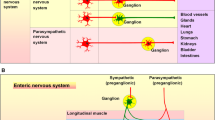Abstract
Glycine concentrations in individual cell bodies of the identified giant neurons R3–R14 in the parietovisceral ganglion of the mollusc Aplysia californica are up to 20 times higher than in neighboring neurons (Iliffe et al., 1977). High concentrations of putative neurotransmitters are present in invertebrate neurons thought to use those compounds as transmitters (Otsuka et al., 1967; Rude et al., 1969; McCaman et al.; Weinreich et al., 1973). In vertebrates, relatively high concentrations of glycine are present in the ventral grey matter of the spinal cord (Aprison et al., 1975), where glycine is probably used as an inhibitory neurotransmitter by interneurons (Davidson, 1976; Johnston, 1976). Glycine may, therefore, be in high concentrations in R3–R14 for use as a neurotransmitter, particularly since other putative transmitters have not been found in these neurons (Cottrell, 1974; McCaman et al., 1976).
Access this chapter
Tax calculation will be finalised at checkout
Purchases are for personal use only
Preview
Unable to display preview. Download preview PDF.
Similar content being viewed by others
References
Aprison, M.H., Daly, E.C., Shank, R.P., and McBride, W.J., 1975, Neurochemical evidence for glycine as a transmitter and a model for its intrasynaptosomal compartmentation, in “Metabolic Compartment at ion and Neurotransmission” (S. Berl, D.D. Clark, and D. Schneider, eds.), pp. 37–64, Plenum, New York.
Arch, S., 1972, Polypeptide secretion from the isolated parieto-visceral ganglion of Aplysia californica, J. Gen. Physiol., 59: 47–59.
Coggeshall, R.E., 1967, A light and electron microscope study of the abdominal ganglion of Aplysia californica, J. Neurochem., 22: 557–559.
Cottrell, G.A., 1974, Serotonin and free amino acid analysis of ganglia and isolated neurones of Aplysia dactylomella, J. Neurochem., 22: 557–559.
Davidson, N., 1976, “Neurotransmitter Amino Acids,” Academic, pp. 39–56, New York.
De Belleroche, J.S. and Bradford, H.F., 1973, Amino acids in synaptic vesicles from mammalian cerebral cortex: A re-appraisal, J. Neurochem., 21: 441–451.
Frazier, W.T., Kandel, E.R., Kupferman, I., Waziri, R., and Coggeshall, R.E., 1967, Morphological and functional properties of identified neurons in the abdominal ganglion of Aplysia californica, J. Neurophysiol., 30: 1288–1351.
Gainer, H. and Wollberg, Z., 1974, Specific protein metabolism in identifiable neurons of Aplysia californica, J. Neurobiol., 5: 243–261.
Hall, Z.W., Hildebrand, J.G., and Kravitz, E.A., 1974, “Chemistry of Synaptic Transmission,” p. 168, Chiron Press, Newton, Masachusetts.
Hökfelt, T. and Ljungdahl, Å., 1975, Uptake mechanisms as a basis for the histochemical identification and tracing of transmitter specific neuron populations, in “The Use of Axonal Transport for Studies of Neuronal Connectivity,” (W.M. Cowan and M. Cuénod, eds.), pp. 249–306, Elsevier, New York.
Iliffe, T.M., McAdoo, D.J., Beyer, C.B., and Haber, B., 1977, Amino acid concentrations in Aplysia nervous system: neurons with high glycine concentrations, J. Neurochem. 28: 1037–1042.
Iversen, L.L., Dick, R.F., Kelly, J.S., and Schon, F., 1975, Uptake and localization of transmitter amino acids in the nervous system, in “Metabolic Compartmentation and Neurotransmission,” (S. Berl, D.D. Clarke, and D. Schneider, eds.), pp. 65–90, Plenum, New York.
Johnston, G.A.R., 1976, Amino acid inhibitory transmitters in the mammalian nervous system, in “Chemical Transmission in the Mammalian Central Nervous System,” (C.H. Hockman and D. Bieger, eds.), pp. 31–81, University Park Press, Baltimore.
Kuhar, M. J., 1973, Neurotransmitter uptake: A tool in identifying neurotransmitter-specific pathways, Life Sciences, 13: 1623–1634.
McCaman, R.E. and McCaman, M.W., 1976, Biology of individual cholinergic neurons in the invertebrate CNS, in “Biology of Cholinergic Function,” (A.M. Goldberg and I. Hanin, eds.), pp. 485–513, Raven Press, New York.
Otsuka, M., Kravitz, E.A., and Potter, D.D., 1974, Physiological and chemical architecture of a lobster ganglion with particular reference to gamma-aminobutyrate and glutamate, in “Chemistry of Synaptic Transmission”, (Z.W. Hall, J.G. Hildebrand, and E.A. Kravitz, eds.), pp. 183–210, Chiron Press, Newton, Massachusetts.
Peters, T., Jr. and Ashley, C.A., 1967, An artefact in radioautography due to binding of free amino acids to tissues by fixatives, J. Cell Biol., 33: 53–60.
Rude, S., Coggeshall, R.E., and Van Orden, L.S. III, 1969, Chemical and ultrastructural identification of 5-hydroxytryptamine in an identified neuron, J. Cell Biol., 41: 832–854.
Schwartz, H.J., Castellucci, V.F., and Kandel, E.R., 1971, Functioning of identified neurons and synapses in abdominal ganglion of Aplysia in absence of protein synthesis, J. Neurophysiol., 34: 939–953.
Werman, R., 1966, A review — criteria for identification of a central nervous system transmitter, Comp. Biochem. Physiol., 18: 745–766.
Weinreich, D., McCaman, M.W., McCaman, R.E., and Vaughn, J.E., 1973, Chemical, enzymatic and ultrastructural characterization of 5-hydroxytryptamine-containing neurons from the ganglia of Aplysia californica and Tritonia diomedia, J. Neurochem., 20: 969–976.
Author information
Authors and Affiliations
Editor information
Editors and Affiliations
Rights and permissions
Copyright information
© 1978 Plenum Press, New York
About this chapter
Cite this chapter
Price, C.H., McAdoo, D.J., Coggeshall, R.E., Iliffe, T.M. (1978). Identified Aplysia Neurons with Rapid and Specific Glycine Uptake. In: Fonnum, F. (eds) Amino Acids as Chemical Transmitters. NATO Advanced Study Institutes Series, vol 16. Springer, Boston, MA. https://doi.org/10.1007/978-1-4613-4030-0_16
Download citation
DOI: https://doi.org/10.1007/978-1-4613-4030-0_16
Publisher Name: Springer, Boston, MA
Print ISBN: 978-1-4613-4032-4
Online ISBN: 978-1-4613-4030-0
eBook Packages: Springer Book Archive




